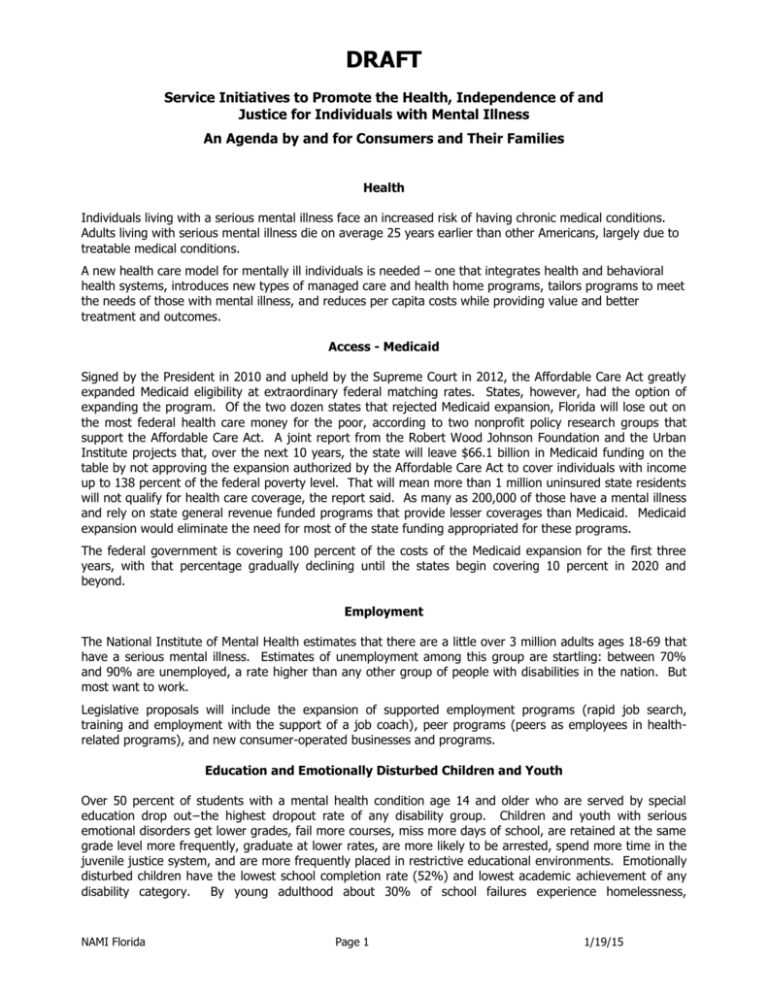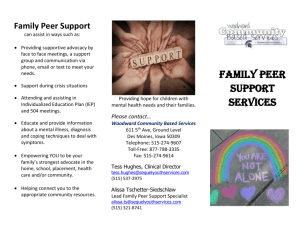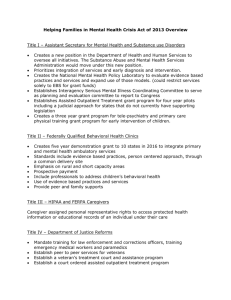Legislative Priorities Draft
advertisement

DRAFT Service Initiatives to Promote the Health, Independence of and Justice for Individuals with Mental Illness An Agenda by and for Consumers and Their Families Health Individuals living with a serious mental illness face an increased risk of having chronic medical conditions. Adults living with serious mental illness die on average 25 years earlier than other Americans, largely due to treatable medical conditions. A new health care model for mentally ill individuals is needed – one that integrates health and behavioral health systems, introduces new types of managed care and health home programs, tailors programs to meet the needs of those with mental illness, and reduces per capita costs while providing value and better treatment and outcomes. Access - Medicaid Signed by the President in 2010 and upheld by the Supreme Court in 2012, the Affordable Care Act greatly expanded Medicaid eligibility at extraordinary federal matching rates. States, however, had the option of expanding the program. Of the two dozen states that rejected Medicaid expansion, Florida will lose out on the most federal health care money for the poor, according to two nonprofit policy research groups that support the Affordable Care Act. A joint report from the Robert Wood Johnson Foundation and the Urban Institute projects that, over the next 10 years, the state will leave $66.1 billion in Medicaid funding on the table by not approving the expansion authorized by the Affordable Care Act to cover individuals with income up to 138 percent of the federal poverty level. That will mean more than 1 million uninsured state residents will not qualify for health care coverage, the report said. As many as 200,000 of those have a mental illness and rely on state general revenue funded programs that provide lesser coverages than Medicaid. Medicaid expansion would eliminate the need for most of the state funding appropriated for these programs. The federal government is covering 100 percent of the costs of the Medicaid expansion for the first three years, with that percentage gradually declining until the states begin covering 10 percent in 2020 and beyond. Employment The National Institute of Mental Health estimates that there are a little over 3 million adults ages 18-69 that have a serious mental illness. Estimates of unemployment among this group are startling: between 70% and 90% are unemployed, a rate higher than any other group of people with disabilities in the nation. But most want to work. Legislative proposals will include the expansion of supported employment programs (rapid job search, training and employment with the support of a job coach), peer programs (peers as employees in healthrelated programs), and new consumer-operated businesses and programs. Education and Emotionally Disturbed Children and Youth Over 50 percent of students with a mental health condition age 14 and older who are served by special education drop out−the highest dropout rate of any disability group. Children and youth with serious emotional disorders get lower grades, fail more courses, miss more days of school, are retained at the same grade level more frequently, graduate at lower rates, are more likely to be arrested, spend more time in the juvenile justice system, and are more frequently placed in restrictive educational environments. Emotionally disturbed children have the lowest school completion rate (52%) and lowest academic achievement of any disability category. By young adulthood about 30% of school failures experience homelessness, NAMI Florida Page 1 1/19/15 DRAFT Service Initiatives to Promote the Health, Independence of and Justice for Individuals with Mental Illness An Agenda by and for Consumers and Their Families unemployment, serious drug or alcohol problems and pregnancy hovers around 50% and by age 25, up to 65% have been arrested. Only one in five youth with emotional disturbance pursue some kind of postsecondary education after high school, among the lowest rates of any disability category. New and expanded supported and special education and school mental health programs are needed to improve graduation rates and increase successful transitions to adulthood. New programs are needed to improve high school retention and graduation rates and provide opportunities for a college education. Peer Supports and Workforce A peer provider (e.g., certified peer specialist, peer support specialist, recovery coach) is a person who uses his or her lived experience of recovery from mental illness and/or addiction, plus skills learned in formal training, to deliver services in behavioral health settings to promote mind-body recovery and resiliency. The role of peer support services in mental health services and person centered recovery has been quickly expanding in recent years. Formal training programs for peer support services have been established. At the state level the role of peer support has changed since 2007 when the federal government designated peer support as a Medicaid billable service for adults. As this role expands across states and other payer systems, the peer workforce will continue to grow and gain an increased role in systems of care. The role of the passive consumer of services may be a thing of the past as these individuals become active and valued care providers, developing a new profession and changing how behavioral health care is delivered. Peer providers are now commonplace in some mental health systems. Factors driving this trend include the growing recognition of the reality of recovery from even severe and persistent psychiatric conditions; a political climate that expects cost-effectiveness for public funds; positive outcomes associated with peer support that are equal to or exceed those achieved by professional staff; and a ready labor force. As Florida moves to integrated health systems and health homes there is a growing need for care management, selfmanagement of diseases, and patient navigation of complex health systems. Peers are an ideal workforce to serve as mental health patient navigators. A peer navigator program is proposed to achieve better access to care, treatment, and outcomes. The peer navigator will be an essential member of the health team and provide the following types of services: Conducting an initial assessment with each participating consumer to assess his/her health and wellness status and experience with getting health care In collaboration with the consumer (and, in some cases his or her family and/or care team) setting healthcare and wellness goals Acting as a coach by working with the consumer to help him/her achieve and maintain those goals through behavioral strategies such as shaping, reinforcing, and modeling Navigating the health system with the consumer to include such things as helping the consumer make medical appointments, going with the consumer to appointments, helping the consumer communicate with medical personnel and/or coaching the consumer about ways to talk with medical personnel, helping with any follow-up necessary such as lab tests, getting prescriptions filled or taking paperwork to the consumer's mental health provider Coordinating the consumer's navigation and goals with appropriate provider staff Communicating with clients on a regular basis to keep them engaged and to assess progress Tracking the progress of clients including conducting follow-along assessments NAMI Florida Page 2 1/19/15 DRAFT Service Initiatives to Promote the Health, Independence of and Justice for Individuals with Mental Illness An Agenda by and for Consumers and Their Families Housing Mentally ill individuals are often homeless, constantly move from one substandard housing unit to another, and live in poorly operated assisted living facilities and unlicensed group homes. Using existing housing revenue streams, the state and local governments should develop new independent and supported housing opportunities and alternatives for individuals with mental illness, providing stable and safe living environments. Supportive housing is what people with disabilities want. It is the most integrated type of housing and helps people with mental disabilities be a successful part of the community—an opportunity to which they are entitled under the Americans with Disabilities Act. Supportive housing programs are the most clinically and cost-effective and offer the most integrated housing available for people with mental disorders. Justice Individuals with mental health conditions are significantly overrepresented in the prison and jail population. In a recent five-site study of jail populations, researchers found rates of serious mental illnesses that are three to six times more than those found in the general population. Approximately 20 percent of state prisoners and 21 percent of local jail prisoners have a recent history of a mental health condition. Seventy percent of youth in juvenile justice systems have at least one mental health condition. Florida needs to invest more dollars in jail diversion, specialized courts, mental health care in correctional facilities, and reentry programs, reducing incarceration rates, increasing community treatment rates, and reducing correctional costs. NAMI Florida Page 3 1/19/15








